4th April 2022
Main Topic: A History of the Hotel Metropole – Norma Baird-Murray & Humphrey Morgan
Geraint opened the meeting with a thank-you to the Hall Committee for installing a new Public Address system. Norma and Humph are the guinea-pigs for trying it out.
Geraint asked Derek to explain what was happening at the Thomas Shop and Ithon Terrace. Derek explained that historically flooding has been a problem in the village and reports up to the 1960’s, prior to the installation of the weir in the Ithon, of flooding meant that the cottages at Ithon terrace would have their windows open at the front and back to let flood water ‘in and out’. The weir and a small alteration in the river when the new bridge was built rectified the problem and no flooding occurred until 3 years ago and we have had significant flooding in each of the subsequent years. This has impacted particularly badly on the 2 end cottages in the Terrace. There are 4 sources of flood water. A sewage pipe, water direct from the river, water from the road, and water pouring down from the Common. Powys County Council, after consulting with Atkins, obtained finance from the Welsh Government, are currently installing a system of pumps that will come into action automatically when flooding is likely. This has involved digging a 6 metre deep hole and other systems in the drive. The contractors have installed a temporary car park for residents. Customers to the Thomas Shop have been asked to park at the Severn Arms for the duration of the work, 2-3 months.
Elizabeth gave advance notice of 2 events: An illustrated talk at Dolau; and a joint event between Radnorshire Society and the Mortimer Society in Knighton on the 14th May.
Geraint asked Shirley to advertise our next event, on the 9th May, the 2nd Monday in May, when she will be talking about “Royal Celebrations” locally. Shirley asked members to rummage in every cupboard to find any material that might be relevant.
Main Topic: A History of the Metropole Hotel
Geraint introduced our 2 speakers and referred to the fact that the Metropole was once run from Penybont. We are very privileged to have, as one of our members, Norma Baird-Murray who has an immense knowledge from her direct involvement in the management of the Metropole for so many years. Humph agreed to support Norma by introducing the subject before handing over to Norma for her in depth knowledge of the Metropole.
- Humphrey Morgan

Humph started by thanking Ray Price for the numerous picture postcards that he had been able to copy. He also thanked Mary Davies for information on Banking and Business Directories that he found invaluable.
When Humph looked around Llandrindod Wells for the first time he wondered about all the Hotels, all the buildings that used to be Hotels, and the substantial Guest Houses, and where the prosperity might have come from to support these undoubtedly successful businesses. Well, three things contributed to the prosperity: 1. The mineral waters within the locality; 2. The Enclosure Act of 1862; and 3. The coming of the Railway in 1865.
- The Mineral Waters
To have an understanding of the mineral waters we have to step back in time some 425 million years ago and how the specific geology of the area laid down rocks in this part of Wales. Geological maps are somewhat colourful, as we see in this map of Great Britain:

The map of Wales illustrates a similar romance:

But little by the way of explanation. Humph thought he would ask our renowned Geologist, Dr Joe Botting, for his explanation. Joe’s only comment was that: “It’s complicated!” Humph decided to leave the explanation at that, but reflected on the fact that there is a significant coming together of the factors that create the mineral waters in this part of Wales. Very locally there are Wells at Llandegley, and Blaen Edw, and slightly further afield at Builth Wells, Llangammarch Wells, and Llanwyrtyd Wells. The geology is complicated and there are a number of mineral waters that appear in different places around Llandrindod. These are: saline, sulphur, magnesium and chalybeate. In Llandegley they had sulphur and saline springs. Access to chalybeate water is still available in Rock Park.
Though the existence of the spa waters had been known about before things took a turn in the middle of the 18th century when a solicitor from Shropshire, William Grosvenor, described as a ‘man of sporting tastes’, stayed at Llandrindod Farm and hatched an idea for an Hotel that would accommodate 300 guests and have dances that could attract 1000 people. How William Grosvenor got to Llandrindod Farm remains something of a mystery as there were no roads across the Common only muddy lanes, a bit like this:

The Hotel opened in 1749 and a description of this, the only hotel, in Llandrindod was:
“Here was accommodation for the invalid of whatever rank and distinction, field amusements for the healthy …balls, billiards and regular assemblies varied the pastimes of the gay and fashionable. The grounds were ornamented in a style of elegance. There were fishponds, a cockpit and race grounds. The systematic management prevailed in the interior of the house… Like a Metropolitan hotel it had shops for milliners, glovers and hairdressers…. etc.”
Obtaining finance for this fairly extraordinary development in this remote part of Wales may have been helped by John Price of Penybont who before becoming one of the very early Bankers in Wales was known to have been a ‘money lender’. His Bank started in 1772 and was active until just before he died in 1798. Other Banks were also available in Kington, Brecon and Aberystwyth.
In 1754 a German Physicist, DW Linden, sparked the real transformation of the area when he visited in an attempt to cure his scurvy. After taking the waters his scurvy was cured! This led him to write a scientific article, an extensive treatise, about the benefit of the ‘waters’ and their curative powers.

While some considered him a bit of a quack, many would follow in his footsteps to take the waters and hopefully receive a cure. As it evolved the cure would be a three week ‘treatment’ of: saline before breakfast; sulphur in the morning and afternoon; and chalybeate after every meal. A more dramatic form of the ‘cure’ was illustrated as:

‘Cure for a fever – sit in the water butt and let the spout run on your head until you feel better.’
- Enclosure Act 1862
The next big change was the Enclosure Act of 1862 that released Llandrindod Common from the restrictions over the potential to build. Ellen Rosenman has written more generally about this radical change to Common Land:
“Between 1750 and 1850, approximately 4000 Enclosure Acts were passed converting commonable land into the exclusive private property of large landowners. According to the working-class politics of the late eighteenth and nineteenth centuries, these acts impoverished small farmers and destroyed the agrarian way of life that had sustained families and villages for centuries. Historians have debated this account of their effects, but for the politicized working classes the Enclosure Acts represented a profound trauma, an extended moment in a narrative of dispossession that undergirded resistance to aristocratic power and urbanization.” https://branchcollective.org/?ps_articles=ellen-rosenman-on-enclosure-acts-and-the-commons
The map below shows Llandrindod Common before the Enclosure Act:

This early map shows the Common between what is now the Automobile Place (5 Ways) and Howey; and Llanerch Common from 5 Ways to what is now Railway Crossing.
- The Coming of the Railway 1865
Bringing a railway line through the heart of Wales was largely due to the investment of Sir Richard Green-Price. He brought the railway initially to Knighton and then on to Penybont and Llandrindod. A Temporary Halt, Llanerch Halt, was built at Llandrindod as it was not until 1868 that the line was extended through to Llanelli. The current station was built in 1905 to serve the now expanding town of Llandrindod Wells. Sir Richard also invested in building the Rock House Hotel one of the many hotels springing up in Llandrindod. It is probably worth mentioning, before we focus on the Metropole Hotel that the first of this wave of hotels was the Pump House Hotel that had an earlier history: “Built by 1805 on the site of the farmhouse of Mrs. Jenkins (who was the first person to promote the spa waters of Llandrindod c.1732); may have started to fill the gap left by the decline of the Grosvenor Hotel; originally just known as “The Pump House”, it was extended early in the 19thC, and again in 1840 under John Cane, who was the first to call it an hotel; customers were divided into first- and second-class, and the two groups were known as the “House of Lords” and the “House of Commons”; in 1888 the Old Pump House was demolished and a new luxury hotel was built.”

What is left of that old hotel which included the Lake in Llandrindod, can be seen in the grounds of the Powys County Council buildings.
With these three changes in the vicinity Llandrindod was ready to expand dramatically and the landowners were quick to exploit its potential. Land was sectioned off into plots and sold off. It looked something like this showing the particulars of the sale for Temple Fields House and Coleman’s Hotel, which will come into Norma’s presentation, and a parcel of land with a frontage to the Turnpike Road, now the main road through Llandrindod and past the Metropole Hotel:

The railway was consolidated in 1905 when Llandrindod was given its own station:


Before handing over to Norma, Humph finished with 2 maps showing Llandrindod in 1887 and as it is today:
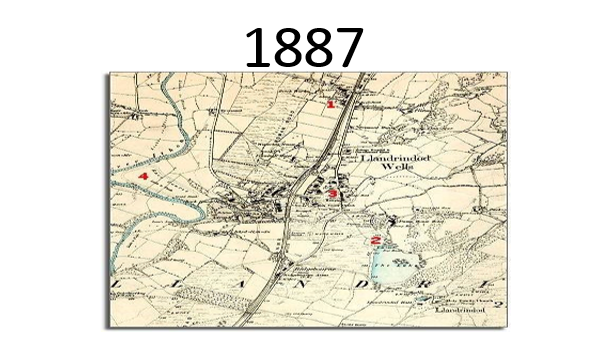

The population of Llandrindod increased from 300 in 1871 to 2800 in 1911. It is now 5309.
- Over to Norma Baird-Murray
Norma started with a cry of No! when Geraint asked her to do this talk. “I am too old and my memory is all but disappeared!” “You are warned”, she added. Her first mistake was to think she was only to talk about the Wilding family and their connection to the Metropole. She only discovered on ‘Face Time’ that she was to give the talk on the Metropole. In a way this was better as there are far too many of the Wildings.
As Humph has told us above, Middleton-Evans was a very wealty man who owned land across Llanbadarn fawr Farm, Noyadd, Trefonen, and Wernoch. By 1900 his entire estate was sold after a ‘slow start’. Middleton-Evans needed people with a vision to spend their money on Guest Houses, shops, etc and to create their own wealth out of this piece of Common Land.
In 1870 Edwin Coleman was an early developer who was brave enough to invest his capital.
The Coleman family who had settled in Howey some years prior to Edwin Coleman purchasing the land for the first Hotel in 1870. While she had hoped to find a connection between Thomas Coleman and the Mustard Colemans, she did find that he had been paid £1 12s 3d for iron work on Howey School in 1857/8. It was however Edwin who bought the 3 plots in 1870 opposite Temple Gardens and on a bit of a track, certainly not a road:
This link with Howey in those early days highlighted the rivalry between the two places. Howey initially saw itself as more important than Llandrindod. The rational being that the postal service was managed from Howey after being sorted in Builth. Indeed the address for Llandrindod was ‘Llandrindod near Howey’. Letters came by coach from Builth to Howey. At Howey they changed to another coach that went to Llandrindod and Cefnllys. Howey and Penybont were, at this time, the important villages in the area and both had their own Post Office. The coaches always travelled during the day because of the danger of being intercepted by Highway Men. However when the trains came, and the mail came directly to Llandrindod, Howey was relegated and became ‘Howey near Llandrindod’. (Norma told us that these were “Recollections of John Jones” who was born at Disserth Inn.
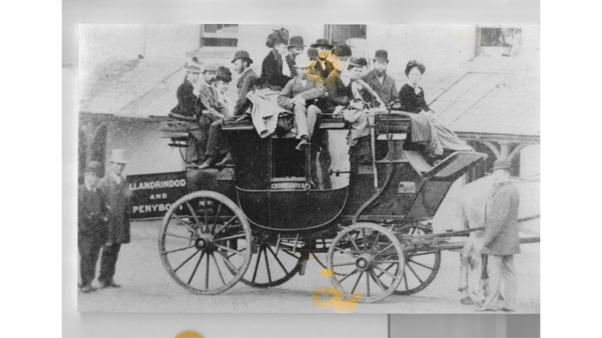
Middleton-Evans sold three sites to Edwin Coleman with certain conditions:
- That all mines, mineral deposits discovered on the site to be used for the benefit of E. Middleton-Evans and his heirs
- That no building be erected without the approval of elevation by Middleton-Evans or his Architects.
- That no building be used as a private lunatic asylum or any other offensive trade.


On the three sites Coleman erected a three-story building, this he divided into three semi-detached houses. One he called Tem[lefield House and the building nearest the Pump House he called Coleman’s Hotel.

By 1872 the hotel was ready to open. It probably had accommodation for about 40 guests. There would not have been any single room occupancy or ensuite facilities. Coleman did take out a licence but was hit by new rules on early closing. It may not have been too much of a problem as Llandrindod was in the very early stage of development and the only other licensees were the Llanerch, the Ridgebourne, and the Middleton. The Pump House was too Grand to admit people from the ‘working Classes’.
The Hotel built up a reputation as a reliable, family and Commercial hotel, which was probably well provided with home grown food from the big garden behind the Hotel and with groceries from the family shop in Howey.

Edwin, at the age of 35 yrs., lost his first wife and was left with the Howey Shop, Coleman’s Hotel, four young sons and an infant daughter. Not surprisingly he found himself a second wife Eliza Meredith from Llanwrthwl. The Meredith family had been settled in the Parish for several centuries.

When Edwin himself died the Meredith family were keen to sell the Hotel and put it on the market with several Agents.
Enter the connection with Penybont. John Wilding,

Owner of the Severn Arms, bought Colemans Hotel in 1885 for £2,200. John wanted to provide a sound source of income for his large family. John Lewis Wilding is still alive, living in Wicklow and he is in regular communication with Norma, and Jennifer Lewis.
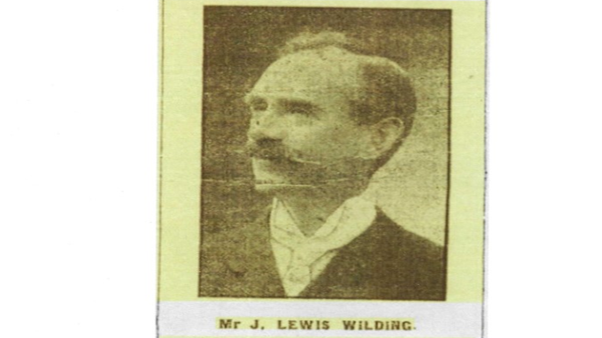
William Wilding took over the running of the Severn Arms and it was said that he was a wonderful fisherman and no fish was safe. He saw the potential of ‘Ye Wells’. Unfortunately, John died on the very day he arranged for his children to become the owners of the Hotel. His wife and the family ran the Hotel for the next 10 years alongside the Severn Arms. At some point during this period they changed the name of the Hotel to The Bridge. The name seems to relate to a small bridge over the Arlais Brook that ran across the road near the Autopalace.

On 1st December 1897 Mrs. Elizabeth Miles bought the Bridge Hotel from the Wildings and in her time until she died in 1930 she would enlarge the Hotel 5 times and increased the number of guests from 40 to 100. Her descendants still run the Hotel today.

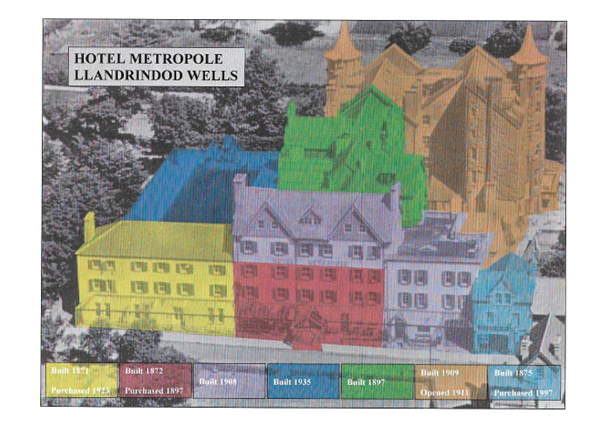
Elizabeth was the youngest of 14 children born to Chadwick Miles an Innkeeper in South Wales. She was a somewhat formidable lady with a vision that saw the Hotel become the biggest in Wales in her time. Elizabeth, according to Ruth Jones, who interviewed a neighbour, Frank Edwards, kept a very close eye on the development of the hotel. She would inspect the work of the builders who were extremely skilled and were expected to lay 800 to 1000 bricks a day. The dust would rise as soon as she appeared. The most telling story of her time was her trip to Norfolk to the closing down sale of the ‘Metropole Hotel’, where she bought a considerable amount of linen, cutlery, crockery, as well as a large number of carpets. Getting to Norfolk by car at her age was an achievement but getting back to Llandrindod having made these purchases must have been something else for a lady who was well past her prime, albeit she did have a chauffeur. When she arrived back at the Hotel still called The Bridge in 1911, her son pointed out that all of the items had been made with a large monogram ‘M’. It was at this point, or so the story goes, that she changed the name of the Hotel to the Metropole. What maybe less certain is that some of the rooms were built to the size of her new carpets.
Not everything has been plain sailing for the Metropole. Norma had not been able to find much information about the 1st World War period but, while the family continued to operate the Hotel, they sold off most of their properties in South Wales.
The Depression of the inter-war years was an extremely difficult time and as they appeared to be coming out of this bleak period the 2nd World War came along. All the large hotels in town were taken over by the Army Authorities for use as Officer Cadet Training Centres or as Hospitals. The Metropole was requisitioned, at a fortnights notice. The contents of the Hotel were sold off at a considerable loss from a marquee on the back lawn– nobody wanted hotel cutlery and linen.
The Hotels were handed back to their respective owners during 1946/47 in very poor condition and totally inadequate compensation. The Metropole was riddled with dry rot which cost £8000 to eradicate. The compensation for the use of the Hotel during the War period was, would you believe, £8000. To re-open the Hotel the family did not find a sale in Norfolk to go to and had to manage with local second hand sales. Rationing and shortages was the order of the day. There were no carpets to be had, no central heating, obsolete kitchen equipment and little prospect of an upturn in the low numbers of people and businesses looking for hotel accommodation. The Hotel was put on the market for £20,000 but there were no offers!
This was a resilient family however and Norma then gave some family background. Elizabeth had 2 sons, William, the eldest, qualified as a Doctor and was very much like his mother, a very shrewd man. The younger son, Francis, not so, he was very good with horses and an expert Polo Player – so she has been told.
Until her death, Granny Elizabeth was very much in charge. She employed mangers – some were good, some not so. After her death the family continued with difficulty through the war years, employing a succession of managers, until David came along. Oops! Lets go back a bit. Dr. William had 3 children through his marriage, Spencer, Elizabeth, and Mary. Elizabeth married Douglas Baird-Murray and they had 2 sons, David and Miles.
Here we got to the really exciting bit! Norma said: “David married ME!” She was Norma Knill. David and Norma, having married in 1958, had 4 children: Sarah, Knill, Justin and Emma.
David came back to the Hotel in 1954 after completing his National Service and then working in hotels in France an Morocco. His mother was ill and the Manager of the Hotel decided to leave. David, at the age of 24, took on the management of the Hotel and became the youngest Licensee in Wales. After his marriage to Norma, they lived in the Hotel for 8 years, between 1958 and 1966. These years were not easy. The Hotel was in poor shape, with very little furniture. They had to do everything themselves. There was no money for improvements, very few rooms to let, it was more like a Boarding House, Norma and David just got on with it. The population locally is very sparce and they had to rely on local business as best they could.
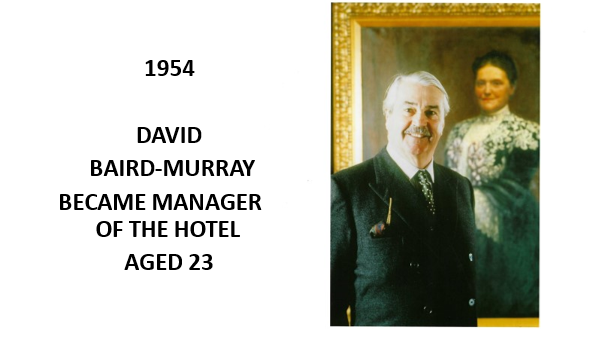
A short season began to emerge, the attraction of Llandrindod Wells to the Victorians had long gone, and it was at Easter that the Governing Body of the Church in Wales would come for their get-together. The season would then end in late September when the Governing Body would again come to the Hotel. These were particularly exciting events as the Hotel would be full and buzzing.

During this period David joined Best Western, a world-wide consortium of independent Hoteliers, who were able to purchase in bulk and share advertising.
David realised he had to take the initiative and begin to attract people to Mid Wales and to Llandrindod Wells. He became involved in a number of organisations connected with the hotel and catering industry. He also joined local groups and the Wales Tourist Board. He visited Coach Companies to persuade them that they could not afford to miss out Llandrindod Wells on their itineraries. He became an activist and chaired the Committee for ‘Sunday Opening’. During 1961 he ran the campaign for Sunday Opening. “Why should we be different from the rest of the country, how embarrassing when you had to turn people away, who called for Sunday lunch, but you could not serve them a drink.” He would take Norma to the NEC in Birmingham and spend many hours persuading people to come to Wales.
This work of promoting not just the Metropole, but persuading people to come to Llandrindod and Wales goes on today. Justin and Judy go to many Shows just to do this. They have had a focus towards Car events selling the Metropole and Wales as the best place to come for weekend meetings.
Sarah and Justin have continued to make improvements to the Hotel and add even more to it. They purchased Worcester House next door, and there is a new Conference suite ‘The David Spencer Suite’. This you can enter straight from the Car Park. The restaurant and Wedgewood Meeting Room have been enlarged with a conservatory. The bedrooms have all been modernised and there are 109 rooms plus 8 Tower Suites. The swimming pool with all mod cons add to making the Metropole a modern hotel.
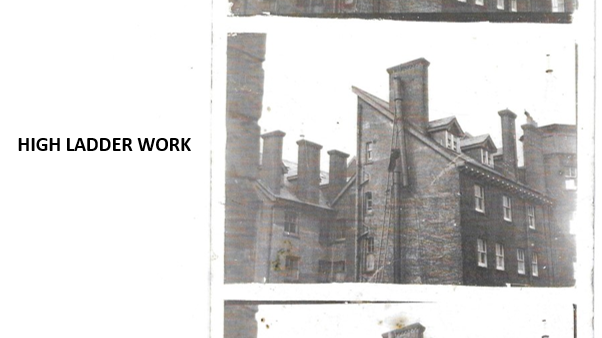
Returning to her favourite occupation, telling stories, Norma showed the above slide of the hotel chimneys. She was given this photo by Mrs Dug Jones. The black blob near the top of the ladder is Mr Dug Jones the Blacksmith working, without any Health and Safety, high up on the Hotel.
Back to cars: The Wildings had built, behind the Hotel, coach houses, barns and whatever their customers of the time required. Great Granny, being the lady she was, was already preparing for the arrival of the motor car in 1910, even before the arrival of the Model T Ford, the first popular car. She asked the Urban District Council for permission to build a row of garages, probably where the stables were, and put in 2 petrol pumps. Possibly the fist petrol pumps in Llandrindod.
David took over what Granny had started and in early 1970 the chimneys were all removed – the story goes that there was enough stone to build three small cottages. The stone was used as hardcore for a new car park. That brought an end to the to the garden, the glass houses and a row of garages. The hotel now has a car park to encourage car clubs to come to Llandrindod.
Norma finished with 2 lovely stories about the Metropole.
In 1951 and 1955 the Monte Carlo Rally came to the Metropole. Along with the cars came Raymond Baxter, the television voice of motor cars. It was a very cold evening when Mr Baxter started his commentary from the Wedgewood Suite. His opening comments were:
“Here we are in Llandrindod Wells, the three coldest places in the World – the North Pole, the South Pole and the Metropole.” Norma said it was true – Central Heating had not yet been installed.
The final story was one that Justin had told to Norma. Peter Walker, then Secretary of State for Wales, Justin met him on a train, his comment was: “The Metropole is like Crewe Station ….. everyone has been there but no one can remember quite why!”
I must mention the Wisteria at the front of the Metropole. Norma did, but not sure when. It was planted in 1923 and is quite the most beautiful plant you could see anywhere when in full bloom:
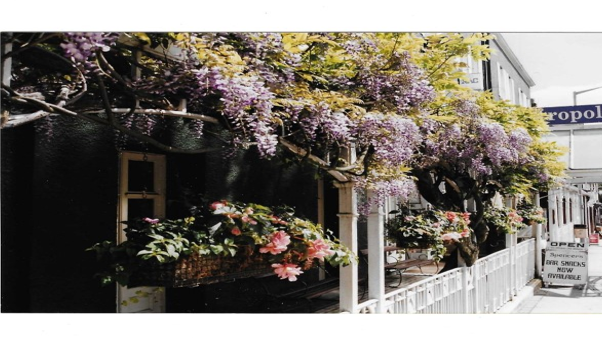
Geraint thanked Norma and Humph for their talk which was clearly very well received by the group. Geriant felt it was probably the most enjoyable session we had had in the last 10 years! Mary was also asked to thank our two speakers.
Hope to see you at our next session when Shirley will be talking about the Royal Celebrations in the Area. The Meeting will not be on the first Monday of the month but on the 9th May in the Hall.